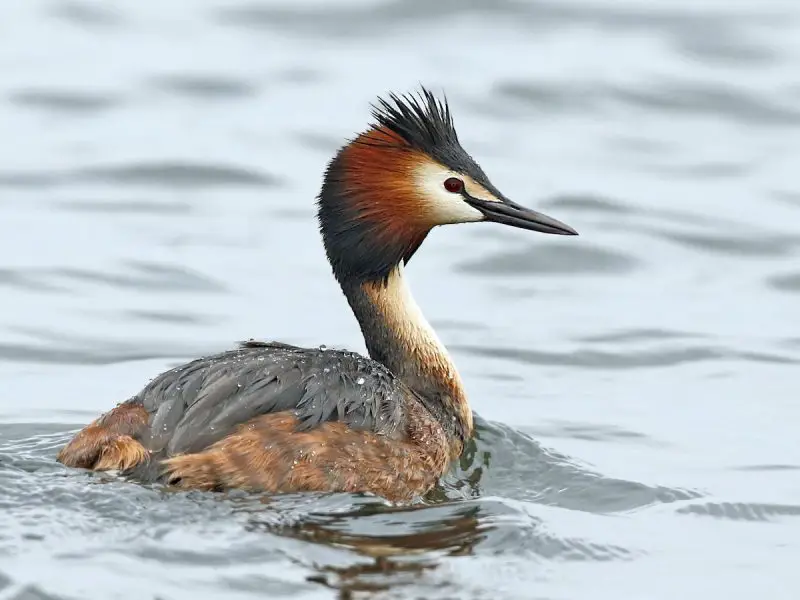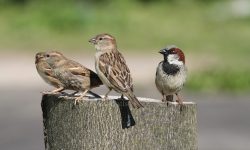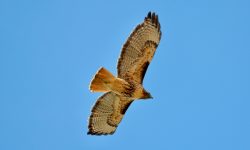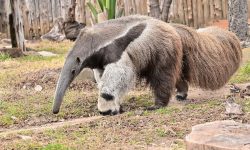Grebes are among the most remarkable waterbirds on Earth. Although they’re often overlooked in favor of more glamorous species like swans or ducks, grebes have evolved an extraordinary set of physical and behavioral traits that make them uniquely adapted to life on the water. Found across the globe, from tropical lakes to icy mountain ponds, these small to medium-sized birds are expert divers, secretive breeders, and surprisingly charismatic performers. Let’s dive into the most fascinating characteristics of grebes that make them a marvel of avian evolution.

1. Streamlined Body Built for Diving
Grebes are built like living torpedoes—every curve of their body serves the purpose of cutting cleanly through water. Their sleek, torpedo-shaped silhouette reduces resistance, allowing them to slip below the surface almost without a ripple. This streamlined form, combined with dense muscles and tightly packed feathers, makes them exceptionally efficient underwater hunters.
What’s especially fascinating is how they position themselves while swimming. Rather than sitting high like a duck, grebes ride low in the water, often with only their slender necks and sharp-pointed bills visible—like periscopes gliding silently across the pond. This not only helps them remain stealthy but also aids in thermoregulation, conserving energy as they stalk fish, insects, and crustaceans beneath the surface.
When they dive, it happens in a flash. With a single, graceful motion, they disappear without a splash, using nothing more than a quick tilt of the body and a powerful push from their lobed feet. They don’t flap their wings or launch like other birds—they simply vanish, leaving behind only a ripple where they once were.
This mastery of aquatic motion places grebes among the most specialized and graceful swimmers in the bird world—an evolutionary marvel of stealth, speed, and efficiency.
2. Lobed Toes Instead of Webbed Feet
Grebes have some of the most peculiar and ingenious feet in the bird world—feet that seem more like biological propellers than anything you’d expect on a bird. Unlike ducks or geese, which rely on webbing stretched between their toes, grebes possess lobed toes: each toe is edged with its own flexible flap of skin, expanding like a paddle when pushed backward and folding like a knife blade when pulled forward.
This design is not only elegant but extremely effective. When a grebe kicks through the water, the lobes open wide, creating strong thrust with minimal effort. Then, as the foot retracts, the lobes collapse to reduce drag, allowing for rapid, smooth strokes. The result is a propulsion system perfectly tuned for diving—one that combines raw power with underwater finesse.
These feet don’t just help grebes swim fast—they help them steer with precision. Grebes can twist and pivot with startling agility while pursuing slippery prey below the surface. Whether darting after a fish or maneuvering through dense aquatic plants, their lobed toes act like finely tuned rudders, giving them unmatched control in three-dimensional space.
It’s an evolutionary masterpiece—proof that sometimes, the best solutions are not copied from others (like webbed feet) but innovated entirely anew. In the world of aquatic birds, lobed toes are grebes’ secret weapon.
3. Legs Set Far Back on the Body
If you’ve ever seen a grebe try to walk, you might think it looks broken. Its steps are awkward, its balance wobbly, and it may even flop onto its belly. But don’t be fooled—this “clumsiness” is actually a sign of extreme specialization. A grebe’s legs are placed so far back on its body that walking becomes a comical afterthought. But in water, this same trait turns the grebe into a sleek, muscular torpedo.
By positioning the legs near the rear, grebes generate incredible forward thrust with each kick. It’s the same principle used in engineering submarines or torpedoes: propulsion is most effective when it comes from behind the center of mass. This rear-engine design lets grebes dive fast, chase prey with precision, and even rocket out of the water when startled.
What they lose on land, they gain tenfold in the water. Their backward-placed legs become natural underwater propellers, pushing them through dense aquatic vegetation or open water with effortless grace. In fact, many grebes can’t even take off from land—they need a running start across the water’s surface to launch into flight.
On shore, grebes may look out of place. But once submerged, they become something else entirely: compact, efficient, and built for an underwater life where every kick counts.
4. Masters of Underwater Hunting
Grebes are not just good swimmers—they are precision predators, born to hunt in a world most birds barely touch. With razor-sharp reflexes, keen underwater vision, and lightning-fast maneuvers, they stalk their prey below the surface like miniature torpedoes in feathers.
Their diet is strictly carnivorous and varies with habitat: shimmering minnows, darting insect larvae, slippery crustaceans, and even tiny frogs fall victim to a grebe’s sudden ambush. What sets them apart is their ability to hunt entirely underwater, not just dipping or dabbling like ducks. A grebe will spot movement, dive silently with a flick of its body, and weave through aquatic plants in a silent chase. With feet acting as steering rudders and bodies sleek as blades, they are built for pursuit.
Even more remarkable, grebes often swallow their catch while still submerged, skipping the usual surface struggle. This saves energy, reduces exposure to predators, and keeps their hunting streamlined—both literally and figuratively.
In the underwater world, where visibility is poor and prey moves fast, grebes thrive with a mix of instinct, stealth, and speed. While their beauty may be most obvious above water, their true brilliance is revealed below, in the silent world where they rule as hunters cloaked in feathers.
5. Feather-Eating Behavior
In the strange and secretive world of grebes, few habits are as baffling—and fascinating—as their compulsion to eat their own feathers. This isn’t a rare accident or a grooming mishap. Grebes deliberately pluck their own downy feathers and swallow them… regularly. Even more astonishing, they feed feathers to their chicks, sometimes as early as their first day out of the egg.
Why would a bird eat something so seemingly indigestible? The answer lies in the grebe’s remarkable digestive strategy. Once inside the stomach, these feathers don’t just pass through. They collect into dense, tangled mats—essentially acting like a biological filter. This feather mat traps sharp fish bones, insect shells, and other hard fragments, forming compact pellets that are later regurgitated safely.
Without this clever adaptation, the grebe’s high-protein diet of spiny prey could wreak havoc on its soft internal tissues. But with a feather lining, their digestive tract is armored from within—nature’s version of internal chainmail.
This behavior is almost unique among birds, and it highlights how specialized grebes truly are. Eating feathers might seem strange, even grotesque, but for these expert divers and hunters, it’s a life-saving habit passed from parent to chick—one mouthful at a time.
6. Waterproof Plumage Maintained by Constant Preening
For a bird that lives and hunts in water, staying dry may seem impossible—but grebes have evolved some of the most water-repellent feathers in the animal kingdom. Their plumage is astonishingly dense, layered in fine, velvety structures that trap pockets of air close to the skin. This trapped air acts as both insulation and flotation device, allowing grebes to stay buoyant and warm even during deep, cold dives.
But this system doesn’t run on autopilot. Grebes are obsessive preeners, devoting hours each day to grooming every feather with meticulous care. Using oil secreted from the uropygial gland at the base of their tail, they coat each feather with a waterproof layer, ensuring that their insulation remains effective and their bodies don’t become waterlogged.
Without this constant maintenance, they would lose their ability to dive, float, and regulate temperature—a dangerous handicap for a bird that rarely leaves the water. Their feather care isn’t vanity—it’s survival. Like divers checking their gear before plunging into the deep, grebes maintain their plumage with the precision of aquatic engineers.
7. Spectacular Courtship Dances
When spring arrives and hormones surge, grebes transform from silent swimmers into elegant performers. In one of nature’s most mesmerizing displays of synchronized beauty, pairs of grebes engage in elaborate courtship dances that rival any ballet on Earth.
Among the most famous is the “rushing ceremony” of the Western and Clark’s Grebes. In this breathtaking display, two birds face each other, mirror each other’s motions, then suddenly rise upright and sprint side-by-side across the water’s surface, necks outstretched, wings held tight, feet slapping in perfect unison. For a few glorious seconds, they appear to walk on water.
These dances are more than dazzling shows—they’re deep expressions of pair bonding, trust, and mutual selection. Each movement, from head shakes to synchronized dives, builds a silent language of courtship. Some species even offer gifts like aquatic plants during these rituals, as if presenting a bouquet.
In the world of birds, few mating displays rival the precision, intimacy, and spectacle of a grebe’s dance. It’s not just a ritual—it’s a performance written in instinct, perfected by evolution, and carried out on the shimmering stage of a quiet lake.
8. Floating Nests Anchored to Vegetation
In the heart of marshes and quiet lakes, where the world is tangled with reeds and reflections, grebes construct nests unlike any others—floating cradles built on water. Using whatever materials the wetland provides—reeds, sedges, bits of algae, even decaying leaves—they weave together buoyant platforms that gently rise and fall with the shifting surface of the water.
These nests are often tethered to emergent vegetation, such as cattails or lily stems, providing stability amid wind and waves. The floating design offers key advantages: it protects eggs from terrestrial predators, shields them from sudden floods, and maintains the right humidity during incubation. Even when water levels rise dramatically, the nest floats up with it, keeping the eggs safe and dry.
From a distance, a grebe’s nest may look like nothing more than a clump of debris. But beneath the camouflage lies a cleverly engineered fortress—hidden in plain sight, expertly insulated, and always adjusting to the rhythms of the wetland world.
9. Chicks Ride on Their Parents’ Backs
In the animal kingdom, few sights are more touching than a grebe family gliding across a still pond—fluffy chicks tucked safely between the wings of their parent, nestled into warmth as they float through the reeds. This isn’t just adorable—it’s an ingenious survival strategy.
Grebe chicks are born covered in soft down and are remarkably alert, but they aren’t ready to navigate the dangers of open water. So from the moment they hatch, they climb aboard—often hitching rides on their parents’ backs for days or even weeks. While one adult dives for food, the other ferries the chicks like a living raft, shielding them from cold water, predators, and exhaustion.
Sometimes, you can see a chick’s tiny head poking out from beneath the parent’s wing, watching the world pass by. Other times, several nestlings huddle together while the adult swims with surprising balance. This behavior also allows the parents to teach by example—diving, surfacing, feeding—while keeping their young close and safe.
It’s one of the most vivid demonstrations of avian devotion, turning every family outing into a moving classroom—and a floating nursery.
10. Cryptic Plumage for Nest Protection
Though some grebes flaunt bold crests, rich chestnut throats, or intricate facial patterns during the breeding season, those flamboyant displays often vanish once they begin incubating eggs. In their most vulnerable moments, grebes trade showiness for survival through subtlety.
During nesting, adults adopt cryptic, earth-toned plumage—a palette of browns, grays, and muted streaks that blends seamlessly into the backdrop of reeds, mud, and dappled shadows. When motionless, a brooding grebe becomes nearly invisible, its form melting into the marsh, protected not by feathers of armor, but by the illusion of disappearance.
This camouflage is critical. Grebes often nest in open wetlands, exposed to predators from above and below. Their subdued plumage, paired with their instinct to freeze when threatened, gives their nests—and their future young—a greater chance at survival. In a world where one careless movement could give everything away, silence and softness become their greatest shields.
11. Silent and Solitary Lifestyle Outside Breeding Season
Once the echoes of courtship fade and chicks have fledged, grebes slip back into the shadows of the wetland—quiet, elusive, and alone. Outside of the breeding season, most grebes abandon social displays and embrace a lifestyle of solitude. They scatter across lakes and ponds, favoring still waters where they can disappear beneath the surface at a moment’s notice.
Unlike ducks or gulls that form noisy flocks, grebes are often solitary hunters, drifting like ghosts through lily pads or hugging the edges of cattails. Their movements are cautious and deliberate. At the slightest disturbance—a paddle splash, a shadow overhead—they dive without a sound, vanishing as if they were never there.
This secretive nature makes them difficult to observe and easy to overlook. Birdwatchers may spend hours scanning a lake, only to glimpse a single grebe surfacing briefly before disappearing again. But this quiet way of life isn’t accidental—it’s a product of their evolutionary trade-off: stealth over spectacle, and seclusion over sociability.
12. Wide Geographic Distribution
Grebes are true citizens of the watery world—a global family quietly thriving in lakes and wetlands across six continents. From tropical lagoons in Central America to misty Scottish lochs and windblown Patagonian marshes, these birds have found a foothold almost everywhere fresh water touches land.
Today, the grebe family (Podicipedidae) includes around 22 recognized species, each shaped by its environment. The tiny Least Grebe, no bigger than a grapefruit, paddles through shallow ponds in Mexico and the Caribbean. At the other extreme, the Great Crested Grebe—elegant, regal, and famed for its courtship dances—glides through the lakes of Europe and Central Asia. In Africa, the Little Grebe is a common sight. In North America, species like the Pied-billed Grebe and Western Grebe fill wetlands from coast to coast.
Though they are most common in freshwater habitats, some grebes have adapted to brackish or coastal waters during migration or winter. Their presence across such a wide range of ecosystems is a testament to their incredible versatility, even as their lives remain deeply tied to the same fundamental element: still, sheltered water.
13. Highly Specialized for Aquatic Life
Few birds are more thoroughly built for water than grebes. Every inch of their anatomy—from the tips of their lobed toes to the oil-sealed down of their feathers—has evolved in service of a life spent afloat. These are not part-time swimmers or dabblers at the edge of the pond; grebes are full-time aquatic specialists, more at home beneath the surface than above it.
Their legs, set far back on the body, make walking awkward, even impossible for some species. In fact, many grebes cannot take off from land at all. To fly, they must race across the water’s surface, flapping madly while their feet slap the water behind them like frantic paddles until they finally lift off—more submarine than bird at the start.
On land, their posture is stooped, their gait clumsy. But in water, they are transformed: sleek, poised, and powerful. They dive not with desperation, but with intent—slipping beneath the surface like falling leaves, reappearing far from where they vanished.
This profound specialization means they’ve sacrificed mobility on land in exchange for mastery below water. In evolutionary terms, grebes haven’t just adapted to aquatic life—they’ve committed to it entirely.
14. Migratory Capabilities Vary Widely
Though they appear built solely for lakes and marshes, many grebes are surprisingly capable long-distance travelers. Some species—like the Red-necked Grebe and the Horned Grebe—undertake seasonal migrations spanning thousands of miles. In spring, they leave their wintering grounds along coasts and large inland lakes, flying high over continents to reach remote northern breeding grounds where the water is cold, the nights are long, and competitors are few.
These journeys require precise timing and incredible stamina, especially for birds that must launch from water rather than land. Migratory grebes often gather in staging areas—large, quiet lakes where they can rest and fatten up before continuing their route. Their migration may not be as flashy as that of geese or cranes, but it’s no less awe-inspiring.
On the other end of the spectrum are resident or partially migratory species like the Pied-billed Grebe, which stays put year-round in warmer regions of North and Central America. For these birds, the key to survival is water that never freezes—if they can find that, they stay. This contrast between globe-trotting grebes and homebody species reflects the family’s deep flexibility and ecological range.
15. Several Species Are Threatened or Endangered
Despite their extraordinary adaptations, grebes are not immune to the pressures of a rapidly changing world. Many species are in trouble—some critically so. Habitat loss is the leading threat. As wetlands are drained, polluted, or overtaken by human development, the quiet reed beds and shallow ponds that grebes depend on are disappearing.
The consequences are heartbreaking. The Alaotra Grebe, once found only on a single lake in Madagascar, was declared extinct in 2010 due to a deadly combination of introduced predatory fish, hunting, and habitat destruction. The Colombian Grebe met a similar fate, vanishing from South America’s wetlands in the late 20th century.
Even species once considered common are in decline. Agricultural runoff poisons their waters, recreational boating disturbs nesting, and invasive plants choke their breeding habitats. Because grebes are so tied to specific aquatic ecosystems, even small changes can have outsized impacts on their survival.
But not all is lost. Conservation efforts—from wetland restoration to invasive species management—are beginning to make a difference. Protecting grebes means protecting the lakes, ponds, and marshes they call home—habitats that support not just birds, but entire ecosystems.
Conclusion
Grebes are a testament to nature’s creativity and precision. Every trait—from their lobed toes to their underwater ballet—is a finely tuned solution to the demands of aquatic life. While they may lack the showy colors of tropical birds or the majesty of raptors, grebes captivate in quieter, more intimate ways. They are swimmers, divers, dancers, and devoted parents—perfectly evolved to thrive on the water’s edge.
Whether you spot a solitary grebe slipping beneath a quiet pond or witness a pair gliding side-by-side in a choreographed courtship, one thing is clear: grebes are among the most fascinating birds you’ll ever meet.






